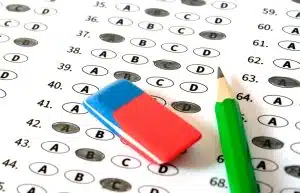Is a 1600 SAT a good score? Is a 4.0 a good GPA?
The modern day 4.0 GPA and 1600 SAT score student is no longer impressive. At least, not if you’re aiming to get into the cream of the crop Top 10/Ivy League universities.
Back then, the Ivy Leagues had a rubric called an Academic Index that was used to rank students according to their academic profile on the basis of their GPA, SAT, SAT Subject Tests, and AP Exam scores. Stronger scores and more exams would correlate to a higher Academic Index, which would be one of the factors for admission. A 4.0 GPA and 1600 SAT score would essentially be a perfect applicant academically.
In addition, the extracurricular profile would get assigned a graded score. For some schools, it was on a scale of 1-5, or 1-10, and that particular score would be assigned to the candidate as well.
But over the course of the past few years, the bar has been raised significantly and the standards for admission have evolved tremendously. The Academic Index is no longer relevant, and in its place is a rubric that requires much higher standards to demonstrate academic proficiency.

Whereas a top academic index would simply mean top grades and test scores, nowadays that’s no longer the case. Too many students have 4.0’s and strong SAT scores to make those academic stats the norm, and instead you now have to do much more on top of that to get in.
The same goes for extracurricular activities. Back then, being involved in school activities and well-rounded was enough to merit a strong extracurricular score. But now, the standards are much higher and you need a unique and differentiated angle to get in, including developing a strong “hook” and standing out from the rest of the applicants out there.
An Asian student who wants to study biology and become a doctor? Good luck. Those applicants are a dime a dozen and playing that card will significantly diminish your odds of admission. Trust us, we’ve seen it happen time and time again.
In fact, it’s not unusual to see high school students with anywhere from 10-15 different extracurriculars on their resume (15!? How on earth do you do 15 activities, you might ask?) on their application to demonstrate the degree of their involvement. At the end of the day, you have to understand that admissions officers accept applications, they don’t necessarily admit students. And so how you market yourself in your application through your extracurricular “hook” matters.
At AdmissionSight, we’ve consistently placed students into the top universities every year. We understand both the level of competition that Ivy-bound students are competing against and the type of academic/extracurricular profile that is necessary to gain a spot at these coveted universities. And we can certainly tell you that the bar is much higher than you may expect. Getting a strong GPA and SAT score only scratches the tip of the iceberg.
While we will certainly evaluate a student’s course selection and standardized test taking schedule, those are really only the bare minimum and the basics and not why you should work with us.
At AdmissionSight, we work with you to first and foremost develop your extracurricular “hook” to differentiate your profile through guided recommendations and unique strategies, formulate a proper academic study plan for you to gain regional or national recognition in different academic competitions, work with you to conduct an original research project to get published, help you accepted into prestigious summer programs, guide you through building your own award winning nonprofit organization, formulate unique essays and narratives for college applications, and so much more.
Needless to say, what’s important is developing a strong academic and extracurricular profile so that our students can compete against the country’s best and brightest.
Academic Competitions and Unique Extracurriculars
Just to give an example, let’s take the Intel Science and Engineering Fair (ISEF), for instance. Many students prepare early on to qualify for this national competition, which would dramatically raise your academic profile in the eyes of the admissions officers.
- Where do you even start?
- How do you run experiments to conduct award winning research?
- Where should you submit your research to?
- How do you know which types research project to take on?
- How do you write your research paper to increase your odds of getting regional or national recognition?
These are just some of the common questions that we guide our students through – and this is just for one activity.
Our students who have qualified for the Intel Science and Engineering Fair, for example, have a significantly higher chance of getting into a top tier school than your stereotypical 4.0 GPA, 1600 SAT score applicant. In fact, we’re one of the only college admissions consulting companies that offer an 8-week Science Research Program specifically to help you place in these national research competitions such as Intel ISEF or Regeneron STS.
The truth of the matter is that there are literally hundreds of different academic competitions and extracurricular activities, and understanding how to take advantage of these opportunities while effectively spending your time and effort to achieve these milestones plays a tremendous role in our monthly consultations that we have with our Private Consulting Program clients.
Over the course of our time together, it’s common for some of the email correspondences with our clients to span over 150-200 emails per given year, including questions about how to raise their academic and extracurricular profile, essays to summer programs, as well as college applications, depending on the year the students joins.
That’s how closely we work with our students to help them get into the university of their dreams.
For a top math and science student, it may mean qualifying for the USA Math Olympiad (USAMO), or entering into the prestigious Intel Science and Engineering Fair, for example. Or pursuing academic research that get published in a university level journal that later inspired this student to establish a unique nonprofit to bolster his odds of admissions.
For a student in the humanities, it may mean placing a spot at the Telluride Association Summer Program (TASP), or earning a 1st place award in a competition within Model United Nations, for instance. If we’re strictly talking about academics, the regional and national competitions are what separate the boys from the men, or girls from the women – not merely grades and test scores. If we’re strictly talking about extracurriculars, then you need a unique, differentiated “hook” by pursuing targeted activities and opportunities to help you stand out from the rest of the competition.
The problem becomes thus two fold:
- Are students and parents aware or knowledgeable of the type of academic competitions or extracurricular activities that would increase a student’s chances at acceptance?
- How do you begin to prepare for these competitions or pursue unique, differentiated extracurricular experiences to increase your odds of success?
Sometimes, we will meet parents and students in their senior year with only strong grades and test scores, maybe 2-3 awards, and a few volunteering experiences, and they think that their child who has a 4.0 GPA and 1600 SAT score is going to Harvard.

Well, you’re in for some tough luck because that type of profile barely scratches the tip of the iceberg of what we consider a truly strong applicant and you’re in for some stiff competition. Like we’ve said, the bar for admissions has been raised much higher.
While a weaker applicant still has a shot at getting in with a strong personal statement, it’s at a diminished probability since the student didn’t take advantage of all those opportunities outside of the standard requirements of admission in GPA and standardized test taking.
In the college admissions world, if you really want the best shot at getting in, all the stars should align. During our consultations, we guide the student on exactly the steps and strategies needed to perform well at these regional and national academic competitions and earn leadership positions in interesting, fascinating extracurricular activities to help build a unique and differentiated profile that no one else can match.
We ensure that no stone gets left unturned, and no opportunity gets left out depending on the student’s interests and intellectual capabilities, whether in the humanities or the math/sciences.
In the college admissions world, there are certainly high impact activities and low impact activities. As seasoned college admissions consultants, we understand the difference among the opportunity set of activities, and set expectations and priorities straight for our students so that they know exactly the path to pursue and the activities to tackle to make them competitive in the eyes of the admissions officers.
The personal statement still matters
And while we often emphasize the importance of the personal statement to get in (and still do), the weaker the grades, scores, and extracurriculars, the lower the chances – that’s without a doubt. We’ve had a much easier time getting a strong student academically and extracurricular-wise than a student who is weaker.
For weaker students, the personal statement may sometimes be enough to sway the minds of the admissions officers, and that’s where we really shine and we know we are going above and beyond to help the candidate.
We’ve always said the weakest student I’ve ever helped get into an Ivy League university had a 3.3 unweighted GPA and a subpar SAT score. Like we said, it has happened before but it’s much harder to accomplish.
Parents and students who think that a 4.0 and 1600 SAT score (while it sounds great in a dinner table conversation with friends and family) are enough to get into a top university are in for a huge surprise.
Because those stats are no longer considered impressive in the eyes of the admissions committee – those stats are considered very average. In fact, there were 12,000 students who applied to Stanford last year with a perfect 4.0 GPA.
In today’s digital era, the equivalent of a 4.0 GPA and 1600 SAT score student 10-15 years ago means accomplishing much more today from an academic and extracurricular standpoint and requires much higher standards to be considered truly competitive and creme of the crop.
Given extremely low acceptance rates of 4-5% and a rising population with millions applying to college every year, along with the improvement in the quality of education and resources, you can imagine why that may be the case.
Some students we’ve worked with have been preparing as early as 5th grade so that they are way ahead of the curve by the time they enter high school when all the marbles are on the table.
Getting into a top university is difficult enough, and they’re crapshoots for anyone given the incredibly low acceptance rates. But if you really want to maximize your chances of getting in, you need to do everything right to get that acceptance letter.
And that means a stellar academic and extracurricular profile and of course, a powerful application to seal the deal.
Note: A stellar academic/extracurricular profile with a weak application can lead to rejections, and vice versa as well. No one said college admissions was easy! 🙂





































